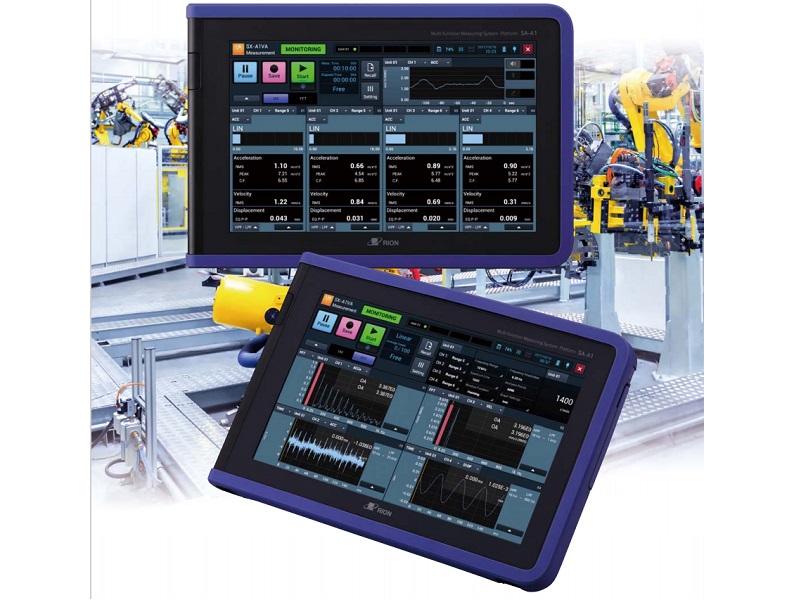This website uses cookies so that we can provide you with the best user experience possible. Cookie information is stored in your browser and performs functions such as recognising you when you return to our website and helping our team to understand which sections of the website you find most interesting and useful.


ITEMLIST
Products Infomation

This program adds vibration measurement functions to the RIONOTE Multifunction Measurement System.
All essential vibration measurement functions are provided, enabling equipment diagnosis and trend management for industrial machinery.
The program also supports detailed diagnosis including FFT analysis and envelope processing, and ISO absolute value evaluation can also be performed.
Because up to four accelerometers can be connected to the RIONOTE, simultaneous measurement in two horizontal directions and one vertical direction or other measurements of multiple planes can be easily realized.
Tri-axial Vibration Analysis Program
Model:
SX-A1VA
Maker:
RION CO.,LTD.
Features
Vibration meter mode
- Measurement simultaneously for vibration acceleration, velocity, and displacement
- Auto store function continuously records vibration values and tacho data in 100 ms intervals
- Calculation of average vibration quantity values for a specified measurement period (to facilitate reading of representative values for measurement data with considerable fluctuation)
- Separate filter settings (HPF, LPF) for acceleration, velocity, and displacement are supported
Use
Simple diagnosis
By periodically measuring the vibration magnitude and comparing the results to a reference value,
the equipment condition (normal or potential problem) can be diagnosed.
Detailed diagnosis (FFT analysis and envelope processing)
The FFT analysis function and envelope processing function (acceleration envelope processing) can be used to determine abnormal conditions and to assess failure stage and location.
Trend management (relative value evaluation)
SX-A1VA program can store the data tagged with information of the measurement point and can output the data all together for each measuring object. By using spreadsheet software such
as Excel enables trend management of the machinery condition. In order to assess changes in the vibration of rotating machinery or similar which can indicate problems and possible causes, it is necessary to effectively accumulate and manage measurement data. Reference values can then be determined based on these data for example to set caution and danger threshold values.
When a caution threshold is exceeded, monitoring should be strengthened, and when the danger threshold is reached, detailed diagnosis will normally be performed. With many common types of vibration acceleration, values that are about 2 to 3 times above normal are considered caution indicators and a further increase by a factor of 2 to 3 will indicate a danger state. For a given piece of machinery, vibration measurement location, measurement direction, and measurement period are determined, and a graph in which measured values are entered in a time series is created (trend management graph).
Specifications
| Number of input channels | Max. 2 (with SA-A1B2) Max. 4 (with SA-A1B4) (Number of logical channels: Using one signal input, settings for analysis of multiple vibration quantities such as acceleration, velocity, displacement, acceleration envelope etc. can be made.) |
|
| Vibration frequency range (using PV-57I) | Acceleration: 0.02 to 141.4 m/s2 (rms) | |
| Velocity: 0.2 to 141.4 mm/s (rms, at 159.15 Hz) | ||
| Displacement: 0.02 to 40.0 mm (EQ peak-peak, at 15.915 Hz) | ||
| Measurement frequency range (Electrical characteristics) | Acceleration: 1 Hz to 20 kHz | |
| Velocity: 3 Hz to 3 kHz | ||
| Displacement: 3 Hz to 500 Hz | ||
| Acceleration envelope: 1 kHz to 20 kHz | ||
| Filters | High-pass filter | 1 Hz, 3 Hz, 5 Hz, 10 Hz, 1 kHz |
| Low-pass filter | 500 Hz, 1 kHz, 5 kHz, 10 kHz, 20 kHz | |
| Vibration meter mode | Acceleration: rms, EQ 0-peak, Waveform peak, Crest factor | |
| Velocity: rms, EQ 0-peak | ||
| Displacement: rms, EQ 0-peak, EQ peak-peak | ||
| Sampling frequency | 51.2 kHz | |
| Store functions | Instantaneous value store, Auto store, Average value store | |
| Threshold evaluation function | Allows setting a threshold value for a vibration quantity, with on-screen indication when the vibration quantity exceeds the threshold during measurement |
|
| ISO absolute value evaluation function | Evaluation of instantaneous value or average value can be performed based on ISO 10816-1:1995/Amd.1:2009 | |
| FFT analysis mode | Power spectrum Time waveform of 1 frame | |
| Frequency range | 100 Hz, 200 Hz, 500 Hz, 1 kHz, 2 kHz, 5 kHz, 10 kHz, 20 kHz | |
| Number of analysis lines | 200, 400, 800, 1 600, 3 200 (Number of sampling points: 512, 1024, 2 048, 4 096, 8 192) |
|
| Time window functions | Rectangular, Hanning, Flat-top | |
| Average processing functions | Linear average, Exponential average, Maximum value hold (MAX) | |
| Display functions | Display units | Acceleration: m/s2, G, in/s2, Velocity: mm/s, in/s, Displacement: mm, μm, mil |
| Waveform recording | Recording of vibration waveform during measurement | |
| Sampling frequency | Vibration meter mode: 51.2 kHz (fixed) | |
| FFT analysis mode: Frequency range x 2.56 | ||
| Quantization bit rate | 24 bit (fixed) | |
| Trigger measurement | Trigger modes | Free, Single, Repeat |
| Trigger source | Vibration meter mode: Vibration quantity, Time, External, Tacho pulse | |
| FFT analysis mode: Waveform, Time, External, Tacho pulse | ||




